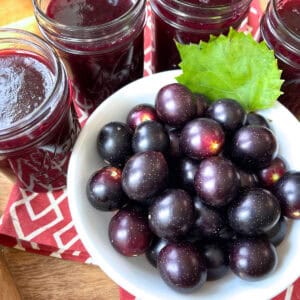
Muscadine Jelly
Made without pectin, this muscadine jelly captures all the flavor and charm of the South's most famous native fruit and is deliciously versatile for both sweet and savory dishes!
Ingredients
- 2 1/2 pounds fresh or frozen muscadines or scuppernongs , washed and drained, any stems/leaves discarded
- 1 cup water
- 3 cups granulated sugar (making jam/jelly without pectin relies on the sugar and decreasing the quantity may interfere with the jelly setting properly)
- 1 tablespoon lemon juice , optional
Instructions
- Slice the muscadines down the center and place them in a large pot. Add the water and slowly bring it to a boil, stirring frequently to prevent scorching. Do not let the fruit burn at any point.Once it comes to a boil, reduce the heat to low-medium, cover and simmer for 30-40 minutes, stirring occasionally to prevent burning. Mash the fruit with potato masher.
- Transfer the mashed fruit and liquid to a food mill positioned over a large bowl. Run the fruit mixture through the food mill allowing all the liquid and pulp to go into the bowl. Discard the leftover skins and seeds. Note: If you don't have a food mill you can press the mixture through a potato ricer or scrape it through a large fine mesh sieve. Measure out 4 cups of juice. If it's just slightly less that's okay. See note below.
- Pour the pureed mixture back into the pot. Bring it to a boil and add the sugar and lemon juice, stirring until the sugar is dissolved. Reduce the heat slightly but keep it at a steady boil for about 20 minutes or until an instant read or candy thermometer registers 220 F / 105 C. I strongly recommend using a thermometer when you're making jams and jellies without pectin because it takes any of the guesswork out of it it terms of when it's done.Alternatively you can test it after about 20 minutes with the wrinkle test: Keep a plate in the freezer during the boiling process so it's nice and cold. Pour a small spoonful of the jelly on the cold plate and wait a few seconds before pushing the jelly with your finger. If it has formed a skin on the top and wrinkles when you push it, the muscadine jelly is done. If it doesn't, continue to boil the mixture and test again.Skim off any foam on top of the jelly.
- Ladle the hot muscadine jelly into sterilized jars and secure with lids. If storing in the fridge, let the jars cool completely before placing them in the fridge. Muscadine jelly or muscadine jam will store in the fridge for a few months. Just check for any signs of mold and discard if there is any present.If canning, follow proper protocol for water bath canning and process the jars for 5 minutes. Carefully remove them, let them cool completely, and store them in a dark, cool place. The muscadine jelly will keep for at least a year.Makes about 4 to 5 half pints.
Notes
- This is a small batch recipe, which makes 4-5 half pints. This muscadine jelly recipe can be doubled.
- I call this muscadine jelly instead of muscadine jam because although I like to leave the pulp in, there are no perceptible "bits" in the final product. The pulp is so fine the result is very much a jelly in its consistency. If you prefer a perfectly clear jelly you can strain the mixture in a fine mesh cheesecloth. Note that this will result in less than 4 cups of liquid so if you plan on straining out the pulp, I recommend using closer to 3 1/2 pounds of muscadines instead of the 2 1/2 pounds called for.
- If you prefer a muscadine jam with some chunks in it, remove some of the mashed fruits before running the rest through the food mill, discard any seeds, and then add them back to the mixture you ran through the food mill.
Nutrition
Serving: 1tablespoonCalories: 37kcalCarbohydrates: 9gProtein: 0.1gFat: 0.1gSodium: 0.4mgPotassium: 29mgFiber: 1gSugar: 7gVitamin A: 10IUVitamin C: 0.1mgCalcium: 5mgIron: 0.04mg
Tried this recipe?Let us know how it was!